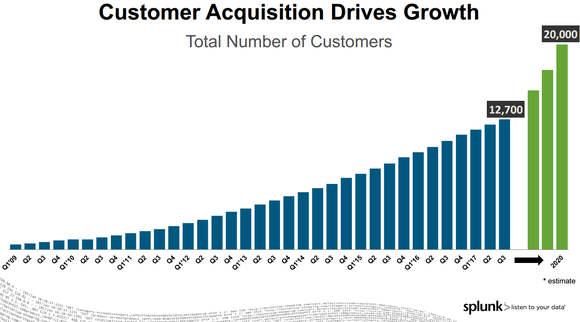Splunk Inc. (SPLK +0.00%) recently announced a new product focused on smaller organizations. Splunk Insights for Ransomware, aimed at fighting a global problem that has organizations throughout the world on edge. Previously ransomware attacks were focused on individuals. Now hospitals, companies, and schools are facing the cyber threat and Splunk is coming to the rescue. In 2016 alone a reported $1 billion was collected by cyber criminals through ransomware.
Splunk is known for its real-time operational intelligence software allowing customers to make sense from data that, simply put, is unstructured and otherwise would not make sense. A great product to work in concert with the big data produced by the Internet of Things.
The real-time attribute is an essential element of Splunk's ransomware protection software as it enables technology departments to analyze, detect, and prevent ransomware from infecting its organization's machines before the damage is done.
As the product is focused on smaller customers it has a user-based pricing model -- customers are charged for the number of users associated with their account -- somewhat different from the company's other products which are based on aggregate data usage.

Image source: Pixabay.
Splunk Insights for Ransomware
Splunk has positioned its Insights for Ransomware as a tool to help smaller or understaffed IT departments. That does not necessarily mean the organizations these departments serve are not large or complex. That is one aspect of this new product that may propel Splunk into more business opportunities beyond ransomware protection.
It paves the way for Splunk to pick up new customers and help current customers, by working within the organization with the department that is chartered with providing security for the entire computer network. The IT department as a hub is more likely to have an overview of other departments within the organization that may have a problem that can be solved by one of Splunk's other software solutions. The bottom-line? Insights for Ransomware gets Splunk in the door.
Splunk in the education market
Splunk is using the headlines seen around the world to aid its marketing outreach to sell its product. Smaller organizations may be the most vulnerable to, and the least able to afford, a ransomware attack and the potential damage it may do to its business.
Today Splunk has about 700 universities around the globe using the company's software. The latest bout of ransomware attacks may help the company grow that number. In 2016 approximately 3% of the company's cloud revenue came from the education sector. Cloud revenue is a major focus for Splunk going forward.
Universities are of interest due to their decentralized organizational structure, tight budgets, and lean IT staff. The IT department is given the difficult task of protecting each school or department that is on the university's network. The added complexity of having thousands of students accessing the network adds an even greater challenge of keeping everyone safe.
Once Splunk is working with a university's IT department its intention is to find leads for opportunities at other departments within the university. Splunk wants a front-row seat to offer a solution powered by the company's software for other problems that are not related to ransomware.
Splunk's business plan
Splunk's goal is to reach 20,000 customers by the end of its fiscal year 2020. At the end of last quarter, the company announced it had approximately 13,500 customers. To hit the 2020 target Splunk needs to offer products that will allow them to reach different areas of the markets that formally might not have known if Splunk can help them.
By introducing this new application of ransomware protection Splunk has capitalized on an opportunity at a time when many organizations IT departments have been looking for a solution. The company is in the right place at the right time.

Image source: Splunk.
The ransomware protection market
The worldwide market for ransomware protection is expected to grow from approximately $8 billion in 2016 to over $17 billion by 2021, at a Compound Annual Growth Rate (CAGR) of 16.3% according to market research company Reportlinker.
Splunk finished last year with $950 million in revenue. The company's goal is to reach $2 billion by fiscal 2020.
Splunk already had a product in the enterprise space to help its largest customers avoid ransomware, by introducing its latest anti-ransomware offering at a lower cost for smaller organizations the company has leveraged its expertise in hopes of finding new opportunities.
